Project Type: Design Competition (2nd place)
Project Period: November 2021
Building Type: Library
Location: Paju Korea
Building Area: 1,257.28㎡
Total Floor Area: 5,431 ㎡
Participant Team: Soohyun Lee
프로젝트유형: 현상공모 (2위)
프로젝트기간: 2021년 11월
건물유형: 도서관
위치: 한국 파주시
건축면적: 1,257.28㎡
총연면적: 5,431 ㎡
참자자: 이수현
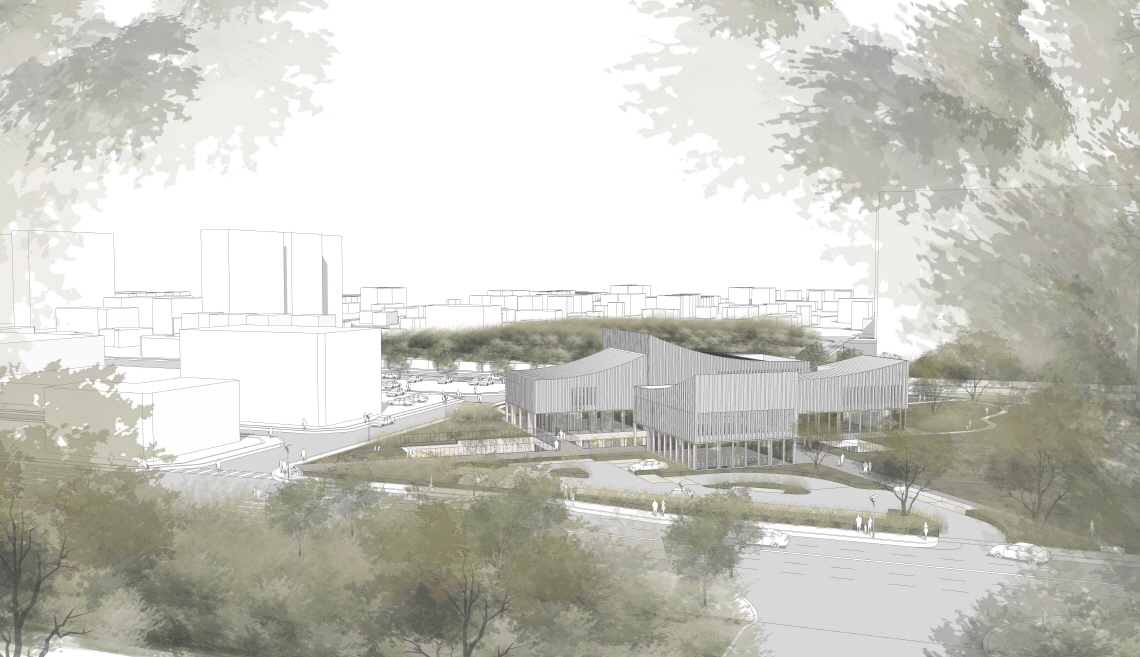
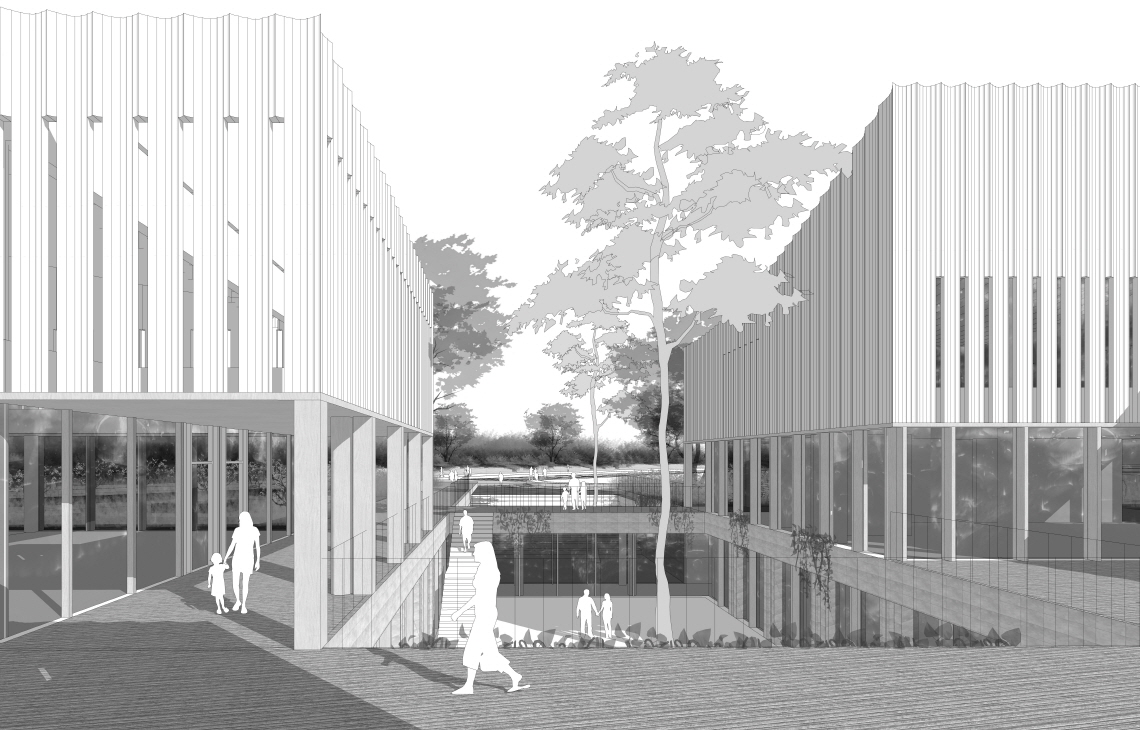
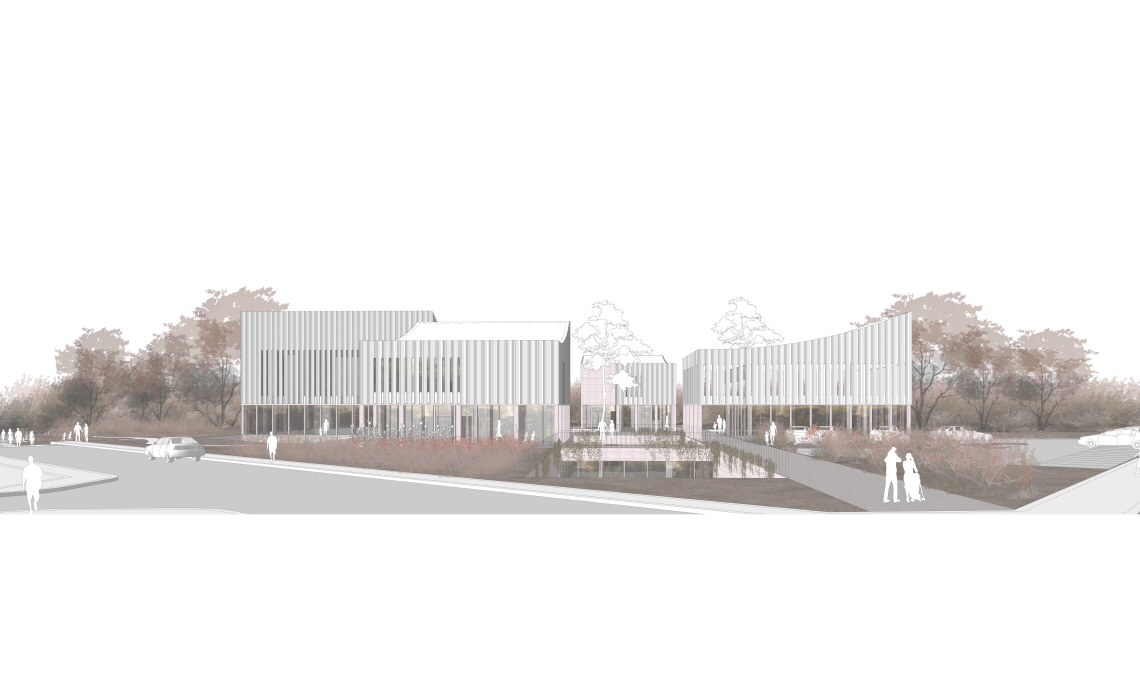
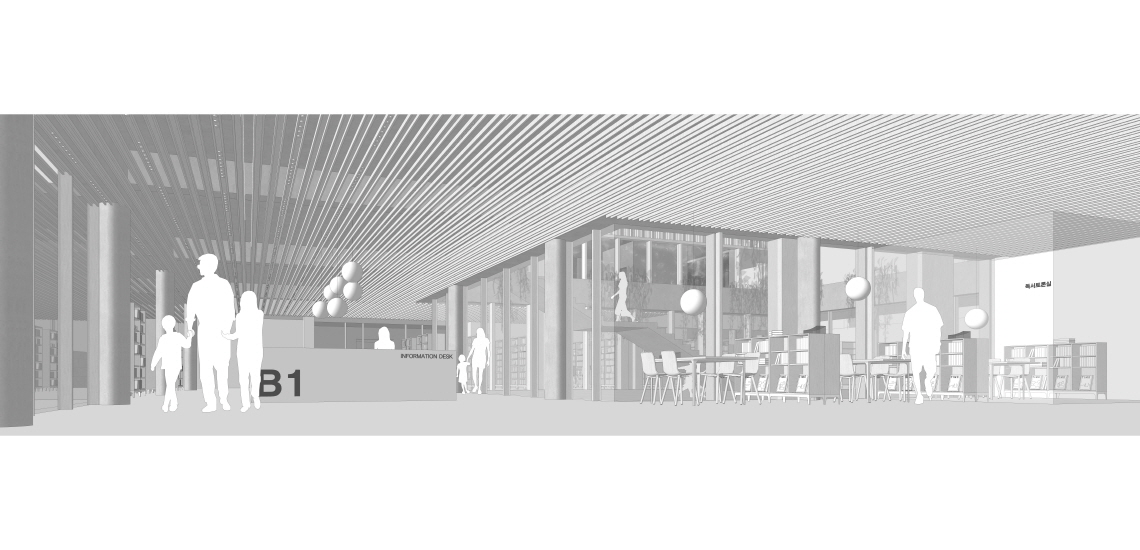
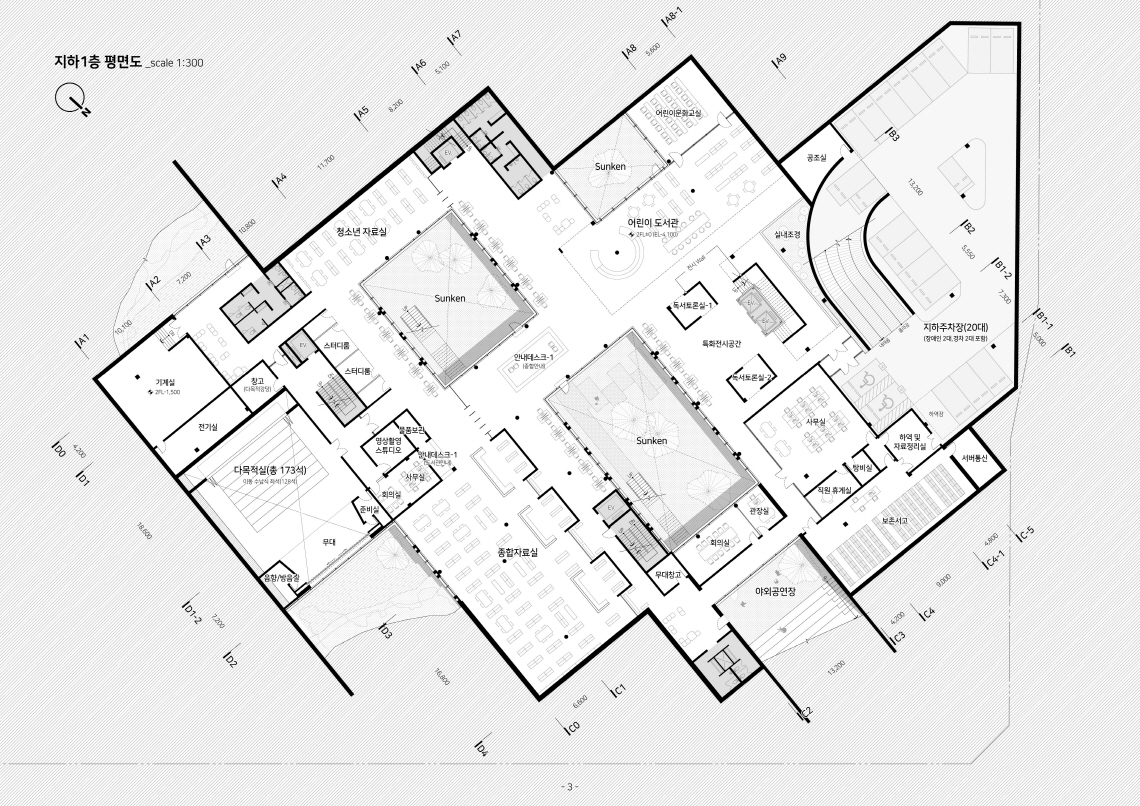
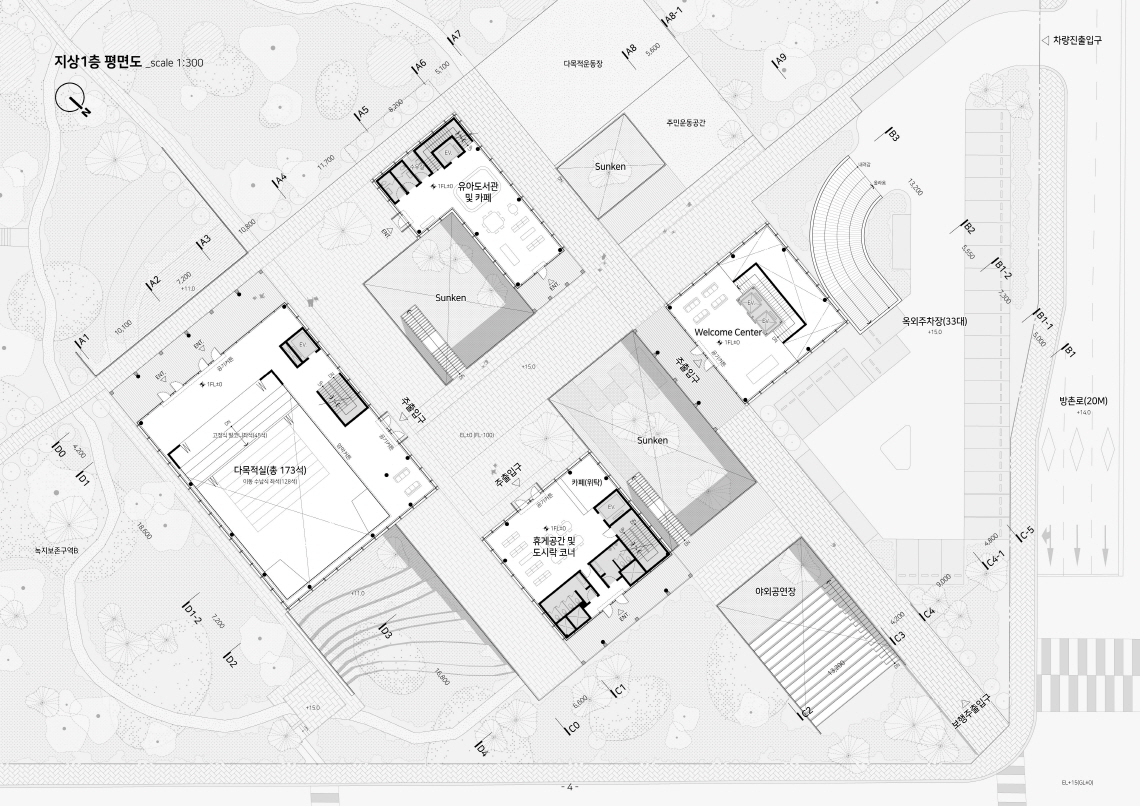
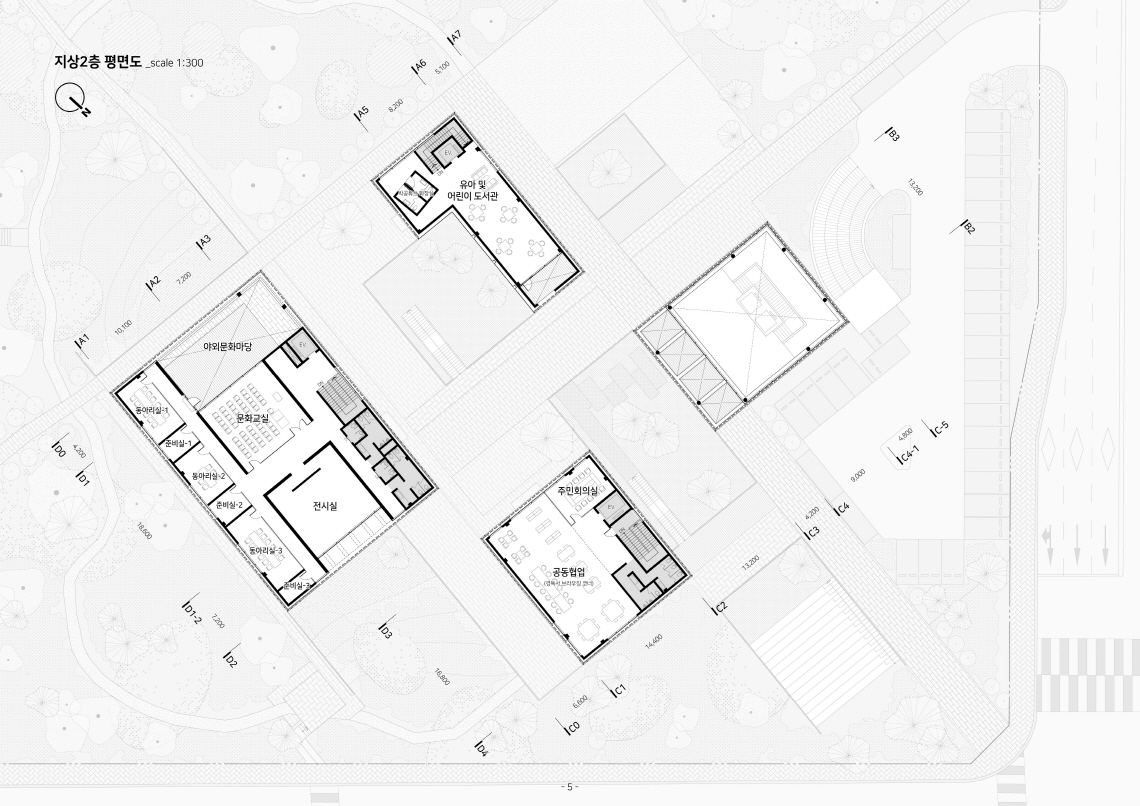
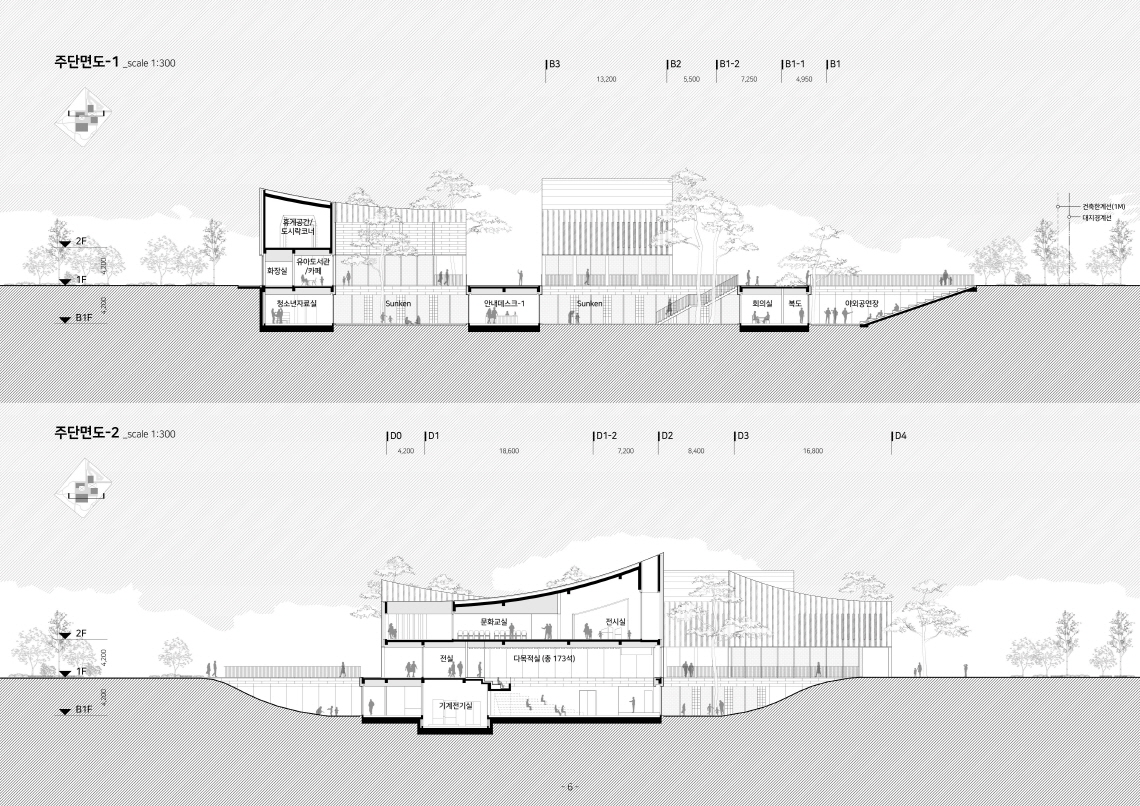
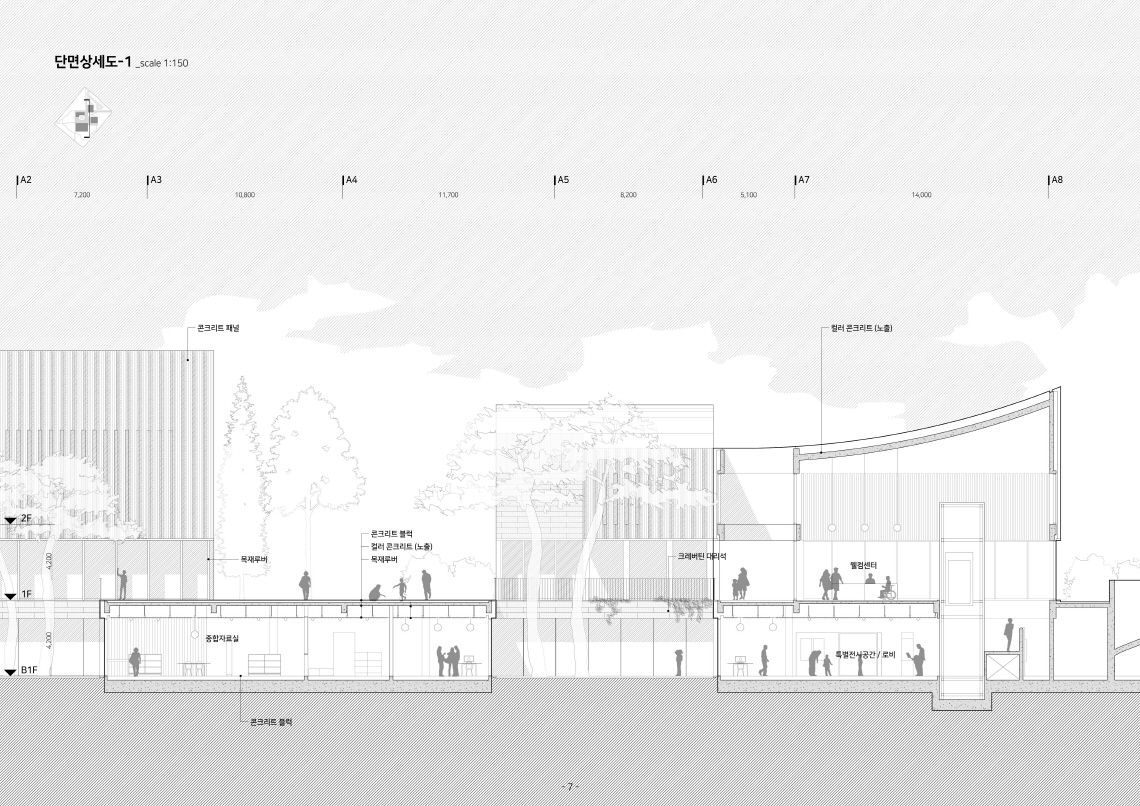
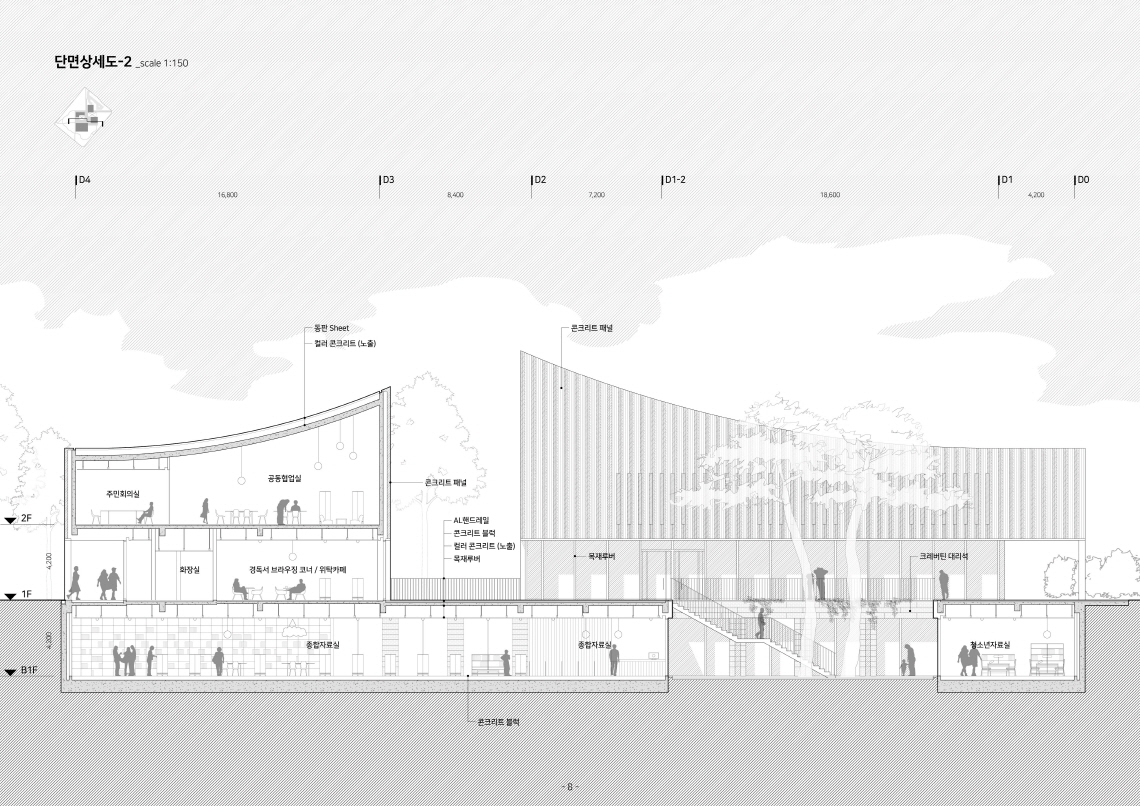
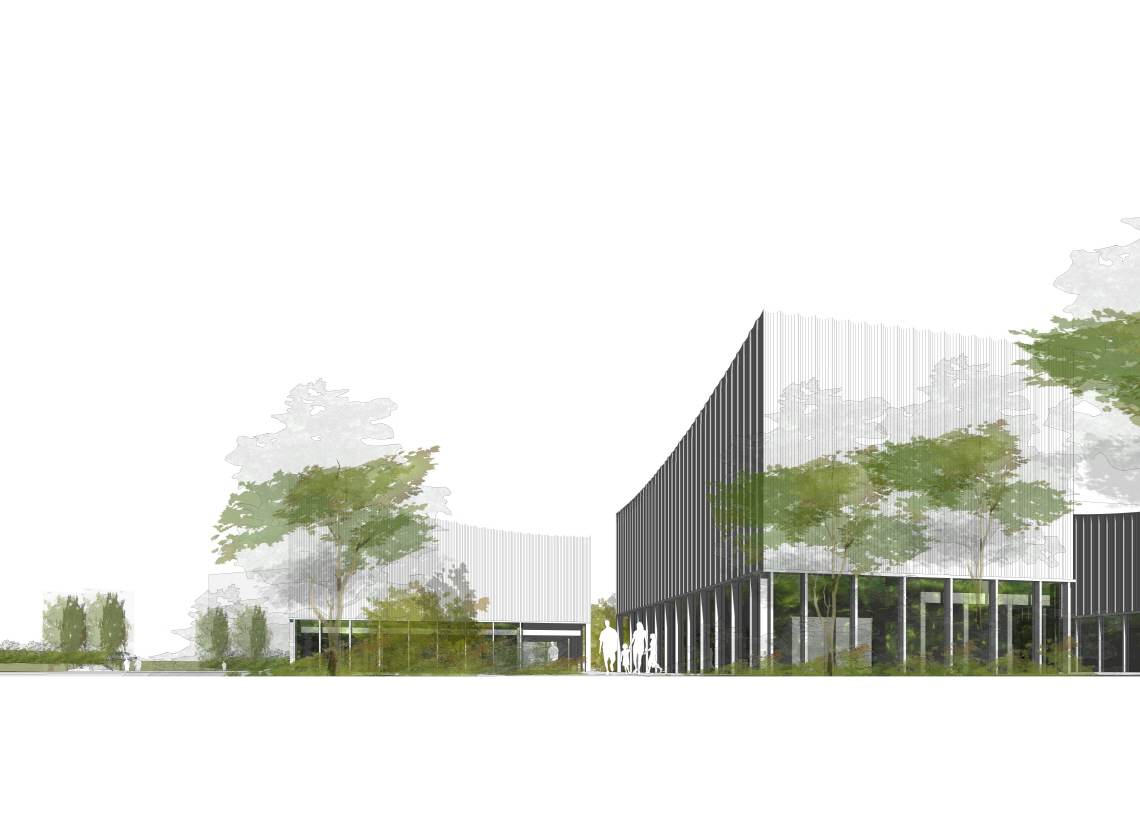
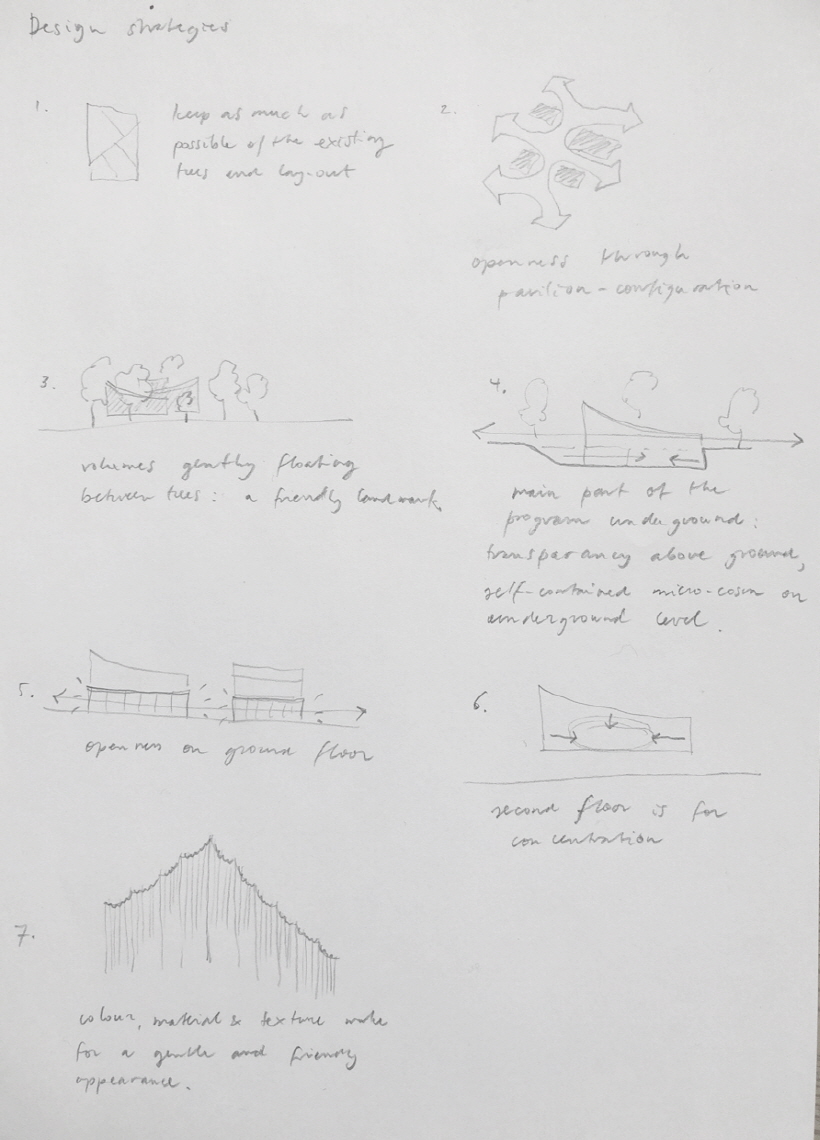
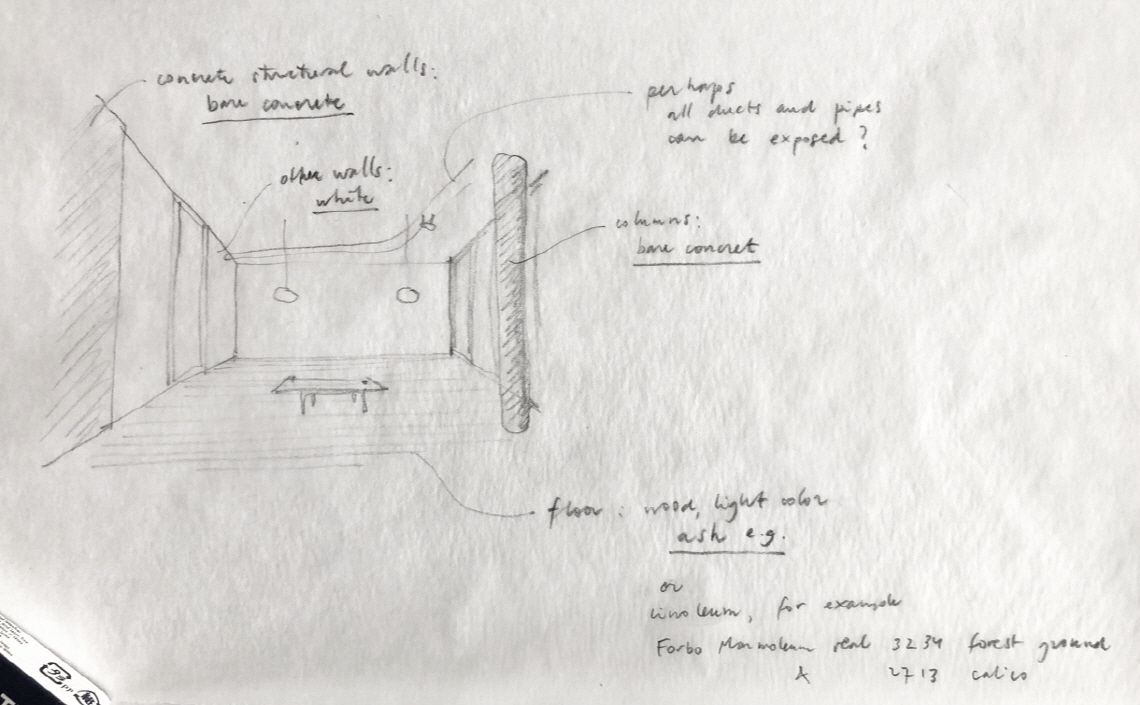
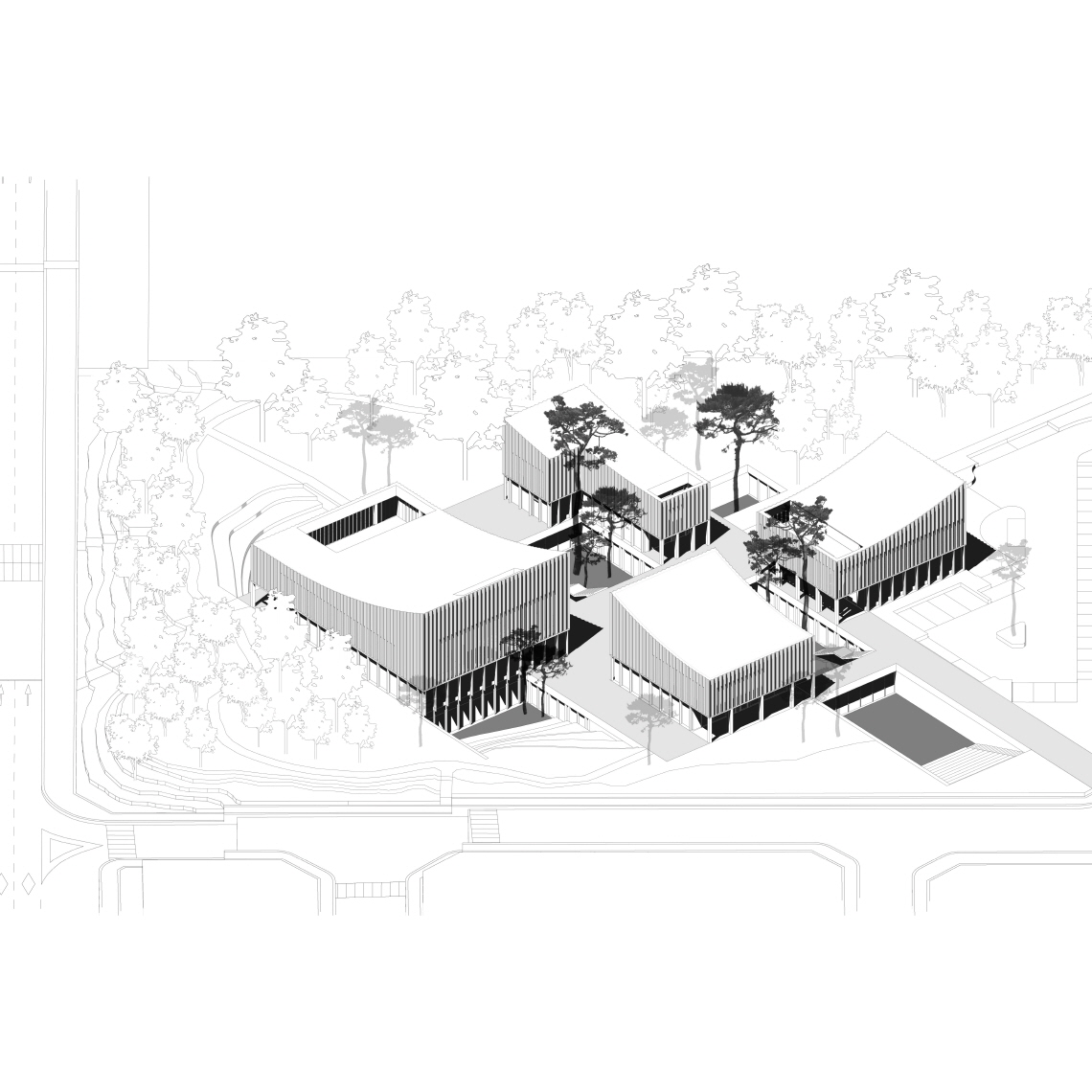
Introduction
The Moonsan Base Library and the surrounding park will fulfill three roles. First, as it is located very close to the border between the South and the North, it will be a symbol of peace, with a design which is very open and inviting, offering space for people to come together. Secondly, as it is close to the DMZ which is a treasure trove of natural and ecological resources, it will be a symbol of ecology, with a design where nature and architecture are interwoven and in harmony. Thirdly, it will offer a place for the community of Paju – both the community of the neighborhood and that of the larger area of the city of Paju – for outdoor activities, cultural activities indoor and outdoor, and social activities for the people of the direct neighborhood, with a design where the open space between the library pavilions merges with the space of the park.
The design features and open pavilion structure above ground, allowing the space of the park to merge with the space of the library, with the volumes of the second floor peacefully ‘floating’ between the trees, and with unified and concentrated spaces of the library underground, around a collection of courtyards. The open space of the park, between the buildings and of the courtyards, with the open layout of the underground floor, together form one open space where leisure, cultural and community activities can interact, and where nature and architecture can merge, offering an open and peaceful atmosphere.
Site analysis
The situation of the site is determined by four factors: 1. it is an open, rectangular field which defining boundaries are streets on three sides and higher apartment buildings on the fourth side, 2. it is central to residential districts west, south and east of it, 3. it is central to the educational institutions of Moonsan High School to the northwest and Moonsan Elementary school to the southeast, and 4. the green space of the park is a link between the larger green areas west and east of the site.
The existing green zones along the southwest and southeast edges of the site offer a good transition to the adjacent areas with the residential towers. The emphasis on the diagonals in the current layout of the park works surprisingly well to give the site the character of a spatially open field, freely extending in the horizontal direction. The difference in height along the southeast edge, finally, opens up the possibility to extend the park in the third dimension as well.
Program analysis
Apart from the common space and the serving spaces (including the parking), it seems logical to us to distinguish five main components of the program:
1. The open outdoor space of the park, to be used for exercise, leisure and rest, for outdoor cultural activities, and for community activities. There should be a clear and logical connection with the indoor spaces of the library.
2. General library space with books and reading tables and working seats.
3. Children’s library with books, children’s reading space, infant’s reading space and children’s culture class.
4. The spaces for culture and education, with the multi-purpose room and the cultural lecture room.
5. Office space for the managing staff with offices, staff meeting room and employee rest area.
Concept
The library will be a collection of four pavilions in between the trees of the park, connected on underground level through one large open space, with several courtyards, and with the spaces on second floor in gently curved light-colored volumes floating between the crowns of the trees, making the library into a friendly landmark.
The open space of the park naturally continues in the open space between the pavilions of the library. A strong interaction between inside and outside is secured by the openness of the facades on ground floor level. The spatial and visual connection with the underground level is via the courtyards, physically with courtyard-wide stairs, and indoors with stairs and elevators.
Programmatically, four components of the program each have their own pavilion: general library, children’s library, space for culture and education, and the offices. The division of the program over the levels is to have the most public functions of each part on ground floor, directly accessible, to have the main spaces of the library underground, where they form their own self-contained and tranquil microcosm, and to have the more secluded spaces, which require concentration, on second floor between the crowns of the trees.
The openness of the configuration is a symbol for peace. The pavilions floating gently between the trees show harmony with nature. And the transparency of ground floor and underground level, with its open plan and its courtyards, invite people from the neighborhood and larger Paju city to participate in community and cultural activities. The open pavilion layout ensures that the park stays one connected space, for people to enjoy leisurely or actively.
Design strategies
1. Keep as much as possible of the existing park lay-out and trees: gently fit the library building with what is already present
2. Preserve the openness of the park with a pavilion-type configuration
3. As a whole, the library appears as a collection of light-colored volumes hovering between the trees: a friendly landmark
4. The main part of the program is situated at underground level: this ensures transparency above ground, and creates a self-contained but open microcosm
on underground level
5. The facades on ground-floor level are all glass: to preserve the openness here, and to enhance the hovering quality of the volumes of the second floor. Ground-floor spaces are the most public, where the library is connected to the city.
6. The second-floor spaces are for concentration
7. Colour, material and texture of the second-floor volumes make for a friendly and
unobtrusive appearance of the pavilions, merging with the trees of the park
8. Each of the four main components of the program have their own recognizable territory in the library complex
Process
1. fit the pavilions in the existing park, in such a way as to preserve openness, existing
pathways, and trees
2. excavate underground level to accommodate the largest part of the program
3. organize the underground level with courtyards and built spaces
4. give the second-floor volumes a gently curved roof, and a curtain-like texture, to fit them
visually between the trees of the park, but at the same time to make the library a visual
symbol and landmark.
5. open the facades on ground floor level
6. divide the four main components of the program in clearly recognizable territories in the
building: general library, children’s library, space for culture and education, and the offices
7. give each pavilion its own vertical circulation core
8. organize the car parking in the north-west part of the site, above ground and underground
9. connect underground level and ground level with courtyard-wide stairs, and with the
stepped hall of the multi-purpose room, and the outdoor auditorium
소개
문산 거점 도서관과 주변 공원은 3가지 역할을 수행하게 됩니다. 첫째, 남과 북의 국경과 매우 가까운 이유로 평화의 상징이 되길 원하며, 이를 위해 매우 개방적이고 친근한 디자인으로 계획되었습니다. 둘째, 자연과 생태자원의 보고인 비무장지대(DMZ)와 인접해 있어, 자연과 건축물이 한데 어우러져 조화를 이루는 디자인으로 생태학의 상징이 될 것입니다. 셋째, 인근 지역사회와 더 넓은 지역의 파주시 지역사회를 위한 야외활동, 실내외 문화활동, 지역주민들의 사교활동을 위한 장소를 제공할 예정입니다. 도서관 파빌리온 사이의 열린 공간이 공원의 공간과 합쳐지는 디자인으로, 지상의 개방형 파빌리온 구조와 공원의 공간이 도서관의 공간과 융합되도록 하는 디자인 특징이며, 2층의 볼륨은 나무들 사이에서 평화롭게 '플로팅'하며 집중되며, 지하에는 도서관의 통합된 공간이 마련됩니다. 건물과 마당과 중정 사이의 열린 공간과 지하층의 열린 레이아웃이 함께 여가, 문화 및 커뮤니티 활동이 상호 작용하고 자연과 건축이 융합되는 하나의 열린 공간과 평화로운 분위기를 만들어 냅니다.
사이트 분석
대지의 상황은 4가지 요소에 의해 결정됩니다. 1. 3면이 도로이고 4면이 고층 아파트 건물로 경계를 정의하는 개방형 직사각형 필드입니다. 2. 서쪽, 남쪽 및 동쪽 주거 지역의 중심입니다. 3. 북서쪽으로는 문산고, 남동으로는 문산초등학교의 교육기관의 중심이며, 4. 공원 녹지는 대지의 서쪽과 동쪽을 잇는 공간입니다.
부지의 남서쪽과 남동쪽 가장자리를 따라 있는 기존 녹지 구역은 공동주택이 있는 인접 지역으로 좋은 전환을 제공합니다. 공원의 현재 배치에서 대각선에 대한 강조는 놀라울 정도로 잘 작동하여 부지에 수평 방향으로 자유롭게 확장되는 공간적으로 열린 들판의 특성을 부여합니다. 남동쪽 가장자리의 높이 차이는 결국 공원을 3차원으로 확장할 수 있는 가능성을 열어줍니다.
프로그램 분석
공용 공간과 서빙 공간(주차장 포함)을 제외하고 프로그램의 다섯 가지 주요 구성 요소를 구별하는 것이 논리적으로 보입니다.
1. 공원의 열린 야외 공간: 운동, 여가 및 휴식, 야외 문화 활동 및 커뮤니티 활동에 사용됩니다. 도서관의 실내 공간과 명확하고 논리적으로 연결되어야 합니다.
2. 일반 열람 공간: 책과 독서용 테이블 및 작업용 좌석이 있는 도서관 공간.
3. 책이 있는 문화도서관: 어린이 도서관, 어린이 독서 공간, 유아 독서 공간, 어린이 문화교실.
4. 문화와 교육의 공간: 다목적실과 문화강의실이 있는 문화와 교육의 공간.
5. 관리직원 공간: 사무실, 직원 회의실 및 직원 휴게실이 있는 관리 직원을 위한 사무실 공간.
개념
도서관은 공원의 나무들 사이에 있는 4개의 파빌리온으로 구성된 매스 구성이 될 것입니다. 하나의 큰 열린 공간을 통해 여러 개의 안뜰이 있는 지하공간으로 연결되고, 2층의 공간은 완만하게 구부러진 밝은 색 볼륨의 떠 있는 공간이 될 것입니다. 내부와 외부 사이의 강력한 상호 작용은 1층의 개방으로 확보됩니다. 지하층과의 공간적, 시각적 연결은 안뜰을 통해, 물리적으로는 안뜰 넓이의 계단으로, 실내에서는 계단과 엘리베이터로 연결됩니다.
프로그래밍 방식으로 프로그램의 4개 구성 요소에는 각각 고유한 파빌리온이 있습니다. 일반 도서관, 어린이 도서관, 문화 및 교육 공간, 사무실입니다. 층별 프로그램의 구분은 각 부분의 가장 공적인 기능을 1층에, 직접 접근할 수 있도록 하고, 도서관의 주요 공간을 지하에 두어 독립적이고 고요한 소우주를 형성하는 것입니다. 구성의 개방성은 평화의 상징입니다. 나무 사이에 부드럽게 떠 있는 정자는 자연과의 조화를 보여줍니다. 그리고 1층과 지하층의 투명성은 개방된 계획과 안뜰을 통해 이웃과 더 큰 파주시의 사람들을 지역 사회 및 문화 활동에 참여하도록 초대합니다. 개방형 파빌리온 레이아웃은 공원이 하나의 연결된 공간으로 유지되어 사람들이 여유롭게 또는 활발하게 즐길 수 있도록 합니다.